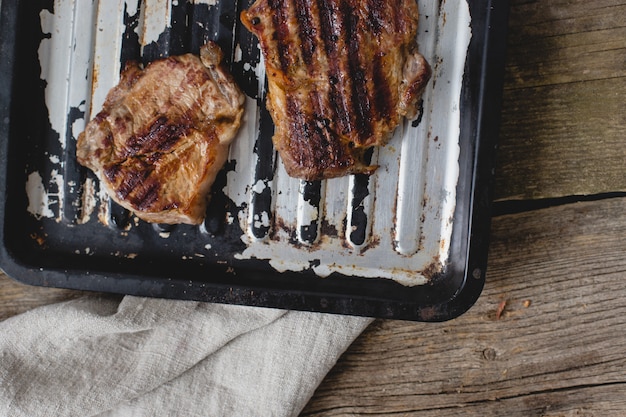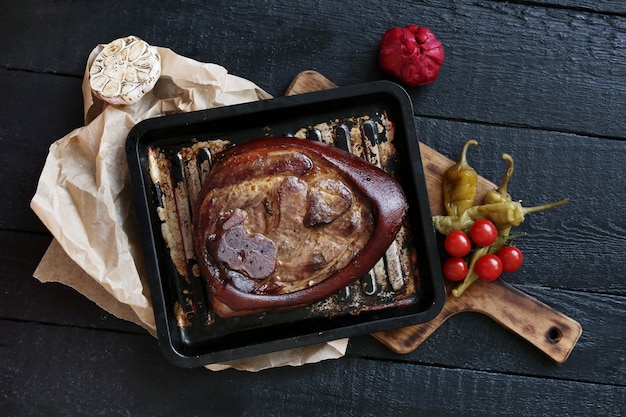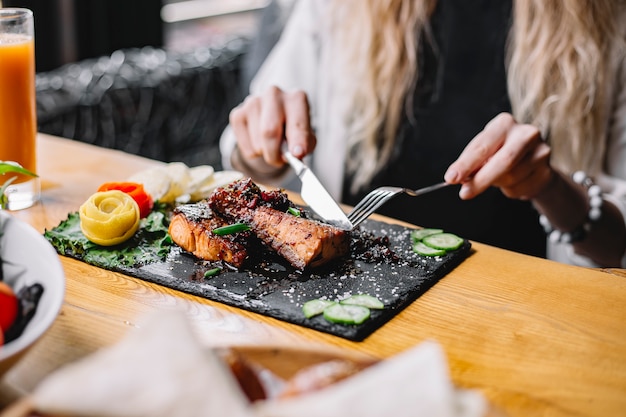(Part 1) All About Flank Steak

Flank steak, for those who haven't met this cut of beef, comes from the abdominal muscles of the cow. It’s a long, flat piece with a distinctive grain running along the length of the meat. And it's lean, with a good amount of marbling, which gives it that rich, beefy flavour we all love.
Why I Love Flank Steak
I'm a big fan of flank steak because it's so adaptable. It's fantastic for stir-fries, fajitas, and even those delicious tacos. Slice it thinly and it’s perfect for salads or sandwiches. It's also great for grilling or roasting. I've even experimented with making beef jerky, which is a bit of a culinary adventure.
The Importance of Marinating
Now, here's the thing about flank steak: It needs a bit of TLC to become a real star. Since it’s a tougher cut, it tends to be a little dry if you don't marinate it properly. Think of marinating as a little spa treatment for your steak, giving it the moisture and flavour it needs.
Marinating Basics
Here's my tried-and-true approach to marinating flank steak:
- Choose your marinade wisely. I keep it simple with olive oil, soy sauce, lemon juice, garlic, and herbs like rosemary or thyme. But hey, get creative! Citrus marinades, honey-soy marinades, or even chimichurri can work wonders. Just make sure the marinade has some acidity (like lemon juice) to tenderise the meat.
- Marinate for at least 2 hours, preferably overnight. The longer you marinate, the better the flavour will penetrate the meat.
- Keep the steak covered in the fridge. This will help prevent bacteria from growing.
- Pat the steak dry before cooking. This will help ensure a nice crispy sear.
(Part 2) Stovetop Cooking Time: Getting It Right

Alright, your steak is prepped and ready to go. Now, let’s talk stovetop cooking time. This is where things get a bit more technical. But don’t worry, I'll break it down step by step.
Understanding the Grain
One of the most important things to remember when cooking flank steak is to cut it against the grain. This means slicing the meat perpendicular to the direction of the muscle fibres. Cutting against the grain helps to tenderise the meat and make it easier to chew. Imagine trying to chew a piece of string – not pleasant, right? Cutting against the grain helps to avoid that.
The Sear: A Crucial Step
The first step to cooking flank steak on the stovetop is to sear it. This creates a crispy crust that locks in the juices and adds a fantastic depth of flavour. Here's how I do it:
- Heat a large skillet or cast iron pan over medium-high heat. You want the pan to be really hot, but not smoking. Think of it like getting a good, hot pan for your pancakes – you want a nice, even heat for cooking.
- Add a tablespoon or two of oil to the pan. I prefer to use a neutral oil like vegetable oil or canola oil. They won't add any extra flavours to compete with your beautiful marinade.
- Sear the flank steak for 2-3 minutes per side. This will create a nice crust and allow the steak to cook evenly. You’ll hear a satisfying sizzle as you sear, and you’ll notice those gorgeous brown bits forming – that’s the good stuff!
Reduce the Heat and Finish Cooking
Once your steak is seared on both sides, reduce the heat to medium-low and continue cooking. You’ll want to cook it to your desired level of doneness. I usually cook it for about 5-7 minutes more, flipping it every couple of minutes. The key here is to cook the steak slowly and evenly.
Resting: A Must-Do
When the steak is done, take it off the heat and let it rest for at least 5 minutes. This allows the juices to redistribute throughout the meat, resulting in a more tender and juicy steak. It’s like letting your steak take a little break before you slice it open.
(Part 3) Checking for Doneness

Okay, so how do you know when your flank steak is cooked to your liking? There are a few ways to check.
The Touch Test
You can use the touch test to get a general idea of the steak’s doneness. Here’s how:
- Press on the centre of the steak with your finger.
- If the steak feels soft, it’s rare.
- If the steak feels slightly firm, it’s medium-rare.
- If the steak feels firm, it’s medium.
- If the steak feels very firm, it’s well done.
The internal temperature
A meat thermometer is the most accurate way to check the steak’s internal temperature. Here are the recommended internal temperatures for flank steak:
- Rare: 125°F (52°C)
- Medium-rare: 130°F (54°C)
- Medium: 140°F (60°C)
- Medium-well: 150°F (66°C)
- Well-done: 160°F (71°C)
(Part 4) Cutting and Serving Flank Steak
Alright, the steak is cooked, it’s rested, and now you’re ready to enjoy. But before you dive in, there’s one more step: cutting.
Cutting Against the Grain
As I mentioned earlier, cutting against the grain is essential for tenderising the steak. This is especially true for flank steak, as it has a distinct grain that can make it tough if cut incorrectly.
Using a Sharp Knife
You’ll want to use a sharp knife to cut the flank steak. This will make cutting it easier and ensure clean, even slices. A dull knife will just make it difficult and could even lead to uneven or ragged cuts.
Serving Suggestions
Flank steak is versatile and can be served in many ways. Here are a few ideas:
- Serve it sliced with a simple salad. A light salad with fresh greens, a vinaigrette dressing, and maybe some grilled vegetables complements the rich flavour of the steak.
- Make a delicious steak sandwich. You can pile it high on a crusty roll with some melted cheese, sauteed onions, and a tangy sauce for a satisfying sandwich.
- Use it in a stir-fry with vegetables and rice. The lean protein of flank steak adds a beautiful balance to a stir-fry, and the thin slices cook quickly and absorb the flavours of the sauce.
- Slice it thinly and serve it with fajitas or tacos. Flank steak is a classic for fajitas, with its rich flavour and ability to hold its own in a spicy marinade. It also works wonderfully in tacos, adding a satisfyingly chewy texture.
(Part 5) Cooking Time Variations
Now, let’s talk about cooking time variations. The exact cooking time for flank steak will vary depending on the thickness of the steak, your desired level of doneness, and the heat of your stovetop.
Thickness Matters
Generally, thicker flank steaks will take longer to cook than thinner steaks. If you’re cooking a very thick flank steak, you may need to cook it for longer to ensure that it’s cooked through. Just keep a close eye on it and use your meat thermometer to make sure it's at the desired temperature.
Doneness Preference
Your preferred level of doneness will also affect the cooking time. If you like your steak rare, you’ll cook it for less time than if you like it well-done. Remember, well-done steak will be cooked for a longer time and may become a bit drier.
Stovetop Heat
The heat of your stovetop will also affect the cooking time. If your stovetop runs hot, you’ll need to cook the steak for less time. If your stovetop runs cool, you’ll need to cook it for longer. It’s all about adjusting to your stovetop and making sure the steak cooks evenly.
(Part 6) Tips for Success
Here are a few tips to ensure a delicious, perfectly cooked flank steak:
- Don’t overcrowd the pan. If you overcrowd the pan, the steak won’t cook evenly. The steak will steam rather than sear, and you won't get that beautiful crust. It’s best to cook in batches if you’re working with a large amount of steak.
- Use a meat thermometer. This is the most accurate way to check the steak’s internal temperature. It’s worth the investment for consistent results.
- Let the steak rest. This allows the juices to redistribute and results in a more tender and juicy steak. A few minutes of rest makes a big difference.
- Don’t overcook the steak. Flank steak can become tough and dry if overcooked. Remember, it’s always better to err on the side of undercooking than overcooking. You can always cook it a little longer if needed, but it’s harder to reverse overcooking.
(Part 7) Troubleshooting
We’ve all been there. You’re cooking a flank steak, you think you’re doing everything right, and then… disaster strikes! No worries, I’ve got you covered.
Steak is Too Tough
If your flank steak is too tough, it’s likely that you overcooked it. Next time, cook it for a shorter amount of time and check the internal temperature with a meat thermometer. Remember, flank steak doesn't need to be cooked to an extremely high temperature for it to be safe to eat.
Steak is Too Dry
If your flank steak is too dry, it’s likely that you overcooked it or didn’t marinate it properly. Next time, make sure to marinate the steak for at least 2 hours, preferably overnight. And remember, it’s always better to err on the side of undercooking than overcooking. You can always cook it a little longer if needed, but it’s harder to reverse overcooking.
Steak is Not Evenly Cooked
If your flank steak is not evenly cooked, it’s likely that you didn’t sear it properly or that the pan wasn’t hot enough. Next time, make sure to heat the pan over medium-high heat until it’s very hot but not smoking. And sear the steak for 2-3 minutes per side to create a crispy crust.
(Part 8) flank steak variations
Okay, so you’ve mastered the basic technique for cooking flank steak. Now it’s time to get creative! Here are a few flank steak variations you can try:
Korean Bulgogi
Korean Bulgogi is a classic dish featuring marinated flank steak that is grilled or pan-fried. The marinade usually contains soy sauce, sugar, garlic, ginger, and sesame oil. You can even find pre-made marinades in Asian grocery stores, making it an easy and delicious meal.
Spicy Mexican Fajitas
Flank steak is perfect for fajitas. You can marinate it in a spicy citrus marinade and then sear it in a hot pan with onions and peppers. Serve it with warm tortillas, salsa, guacamole, and sour cream. The combination of the spicy marinade, the caramelized onions and peppers, and the tangy toppings makes for a delicious and satisfying meal.
Chinese Stir-Fry
Flank steak can also be used in a Chinese stir-fry. Slice it thinly, marinate it in a soy sauce and ginger marinade, and then stir-fry it with vegetables and rice. The thin slices cook quickly, absorbing the flavours of the sauce and creating a wonderful contrast with the crispy vegetables.
(Part 9) FAQs
Q: How long should I marinate flank steak?
You should marinate flank steak for at least 2 hours, preferably overnight. The longer you marinate it, the better the flavour will penetrate the meat. The marinade will tenderise the meat and give it a beautiful depth of flavour.
Q: What is the best temperature to cook flank steak?
The best temperature to cook flank steak depends on your preferred level of doneness. Here are the recommended internal temperatures:
| Doneness | Internal Temperature |
|---|---|
| Rare | 125°F (52°C) |
| Medium-rare | 130°F (54°C) |
| Medium | 140°F (60°C) |
| Medium-well | 150°F (66°C) |
| Well-done | 160°F (71°C) |
Q: Can I cook flank steak in the oven?
Yes, you can cook flank steak in the oven. Preheat the oven to 375°F (190°C). Place the steak on a baking sheet and cook for 15-20 minutes, or until it reaches your desired level of doneness. Let it rest for 5 minutes before slicing and serving. You can also use a broiler for a crispy sear, but make sure to keep a close eye on it to avoid burning.
Q: How do I reheat flank steak?
To reheat flank steak, you can either use a skillet or a microwave. If you’re using a skillet, heat it over medium heat and add the steak. Cook for 2-3 minutes per side, or until heated through. If you’re using a microwave, place the steak on a microwave-safe plate and heat on high for 30-60 seconds, or until heated through. Avoid reheating the steak for too long, as it can become dry.
Q: What are some good side dishes for flank steak?
There are many good side dishes for flank steak, but here are a few of my favourites:
- Roasted vegetables: Roasted vegetables, such as asparagus, broccoli, carrots, and zucchini, are a delicious and healthy side dish for flank steak. The roasted vegetables add a nice sweetness and a wonderful contrasting texture to the steak.
- mashed potatoes: Mashed potatoes are a classic side dish that goes well with flank steak. They provide a comforting and creamy contrast to the rich and savory steak.
- rice pilaf: Rice pilaf is a flavorful and versatile side dish that can be made with a variety of ingredients. It adds a light and fluffy texture that complements the steak.
- Green salad: A simple green salad is a refreshing and healthy way to round out a meal with flank steak. The fresh greens provide a contrasting coolness and lightness to the steak.
Everyone is watching

How to Cook Frozen Lobster Tails Perfectly: A Step-by-Step Guide
RecipesLobster. Just the word conjures up images of lavish meals, special occasions, and a taste of luxury. But let's...

Pigs in a Blanket Cooking Time: How Long to Bake for Perfect Results
RecipesAh, pigs in a blanket. Just the name conjures up images of those delightful little parcels of crispy pastry en...

Pork Fillet Cooking Time: How Long to Cook It Perfectly
RecipesPork fillet, or tenderloin as it's sometimes called, is a real favourite in our house. It's so versatile, and...

The Ultimate Guide to Tender, Juicy Pulled Pork
RecipesRight, let's talk pulled pork. It's one of those dishes that just screams "comfort food," doesn't it? I mean...

The Ultimate Guide to Cooking Sweet Potatoes: From Roasting to Mashing
RecipesSweet potatoes. Just the name conjures up images of warm, comforting dishes, bursts of vibrant color, and a to...
